Basic Reverse Engineering (writeup) - Part 0x01
Introduction
I’ve started a course on Modern Binary Exploitation and throughout this course there are challenges and labs with which to practice exploitation techniques. It starts with an introduction to reverse engineering and I’ve decided to write about how I solved the challenges and take notes of the things I learned.
This (as you can see) is the second post and it will focus on the bombs challenges from the “Extended Reverse Engineering” class. It came out too long, so this post is going to be about only the bomb executable. The cmubomb and crackme0x04_win.exe will be in separate posts.
If you plan to take the course I highly encourage you not to read any further and try to solve the challenges yourself. You’ll learn much more that way.
This time I’ll make use of gdb(pwndbg) and IDA. Also for some of the challenges you don’t need to look at every assembly instruction but just looking at the function calls and byte/string comparisons you can immediately understand what input is expected without reversing the whole thing.
bomb
After starting the bomb executable, we’re presented with four options - YELLOW, GREEN, BLUE and RED, corresponding to the wires that we need to cut to deactivate the bomb. When we choose an option we are asked about a password. Entering the right password cuts the wire and entering the wrong password blows the bomb. Our mission is to reverse the algorithms and find the passwords for each wire and deactivate the bomb.
Let’s start with Yellow.
Yellow
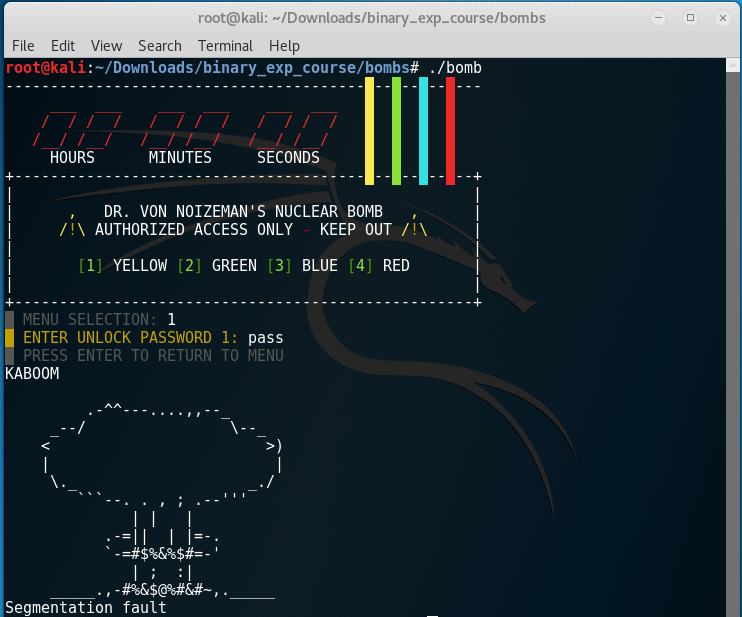
First I list the functions that are present in the executable. I assume that the function yellow handles the logic for the yellow option and disassembling yellow immediately shows something interesting.
$ gdb
pwndbg> file bomb
Reading symbols from bomb...done.
pwndbg> info functions
All defined functions:
Non-debugging symbols:
...............
output omitted
...............
0x08048a4c menu
0x08048fb4 kaboom
0x08048fc8 libc_start_main
0x080491cf disarm_handler
0x080494ca main
0x080496e8 yellow_preflight
0x08049719 yellow
0x080497a4 red_preflight
0x08049831 red
0x080498cc postred
0x080498d4 green_preflight
0x08049904 green
0x080499c0 blue_preflight
0x080499f1 blue
...............
output omitted
...............
pwndbg> disass yellow
Dump of assembler code for function yellow:
0x08049719 <+0>: push ebp
0x0804971a <+1>: mov ebp,esp
0x0804971c <+3>: sub esp,0x8
0x0804971f <+6>: call 0x80496e8 <yellow_preflight>
0x08049724 <+11>: movzx eax,BYTE PTR ds:0x804c24c
; 0x38 = ascii 8
0x0804972b <+18>: cmp al,0x38
0x0804972d <+20>: jne 0x804977c <yellow+99>
0x0804972f <+22>: movzx eax,BYTE PTR ds:0x804c24d
; 0x34 = ascii 4
0x08049736 <+29>: cmp al,0x34
0x08049738 <+31>: jne 0x804977c <yellow+99>
0x0804973a <+33>: movzx eax,BYTE PTR ds:0x804c24e
; 0x33 = ascii 3
0x08049741 <+40>: cmp al,0x33
0x08049743 <+42>: jne 0x804977c <yellow+99>
0x08049745 <+44>: movzx eax,BYTE PTR ds:0x804c24f
; 0x37 = ascii 7
0x0804974c <+51>: cmp al,0x37
0x0804974e <+53>: jne 0x804977c <yellow+99>
0x08049750 <+55>: movzx eax,BYTE PTR ds:0x804c250
; 0x31= ascii 1
0x08049757 <+62>: cmp al,0x31
0x08049759 <+64>: jne 0x804977c <yellow+99>
0x0804975b <+66>: movzx eax,BYTE PTR ds:0x804c251
; 0x30 = ascii 0
0x08049762 <+73>: cmp al,0x30
0x08049764 <+75>: jne 0x804977c <yellow+99>
0x08049766 <+77>: movzx eax,BYTE PTR ds:0x804c252
; 0x36 = ascii 6
0x0804976d <+84>: cmp al,0x36
0x0804976f <+86>: jne 0x804977c <yellow+99>
0x08049771 <+88>: movzx eax,BYTE PTR ds:0x804c253
; 0x35 = ascii 5
0x08049778 <+95>: cmp al,0x35
0x0804977a <+97>: je 0x804978b <yellow+114>
0x0804977c <+99>: mov eax,ds:0x804c124
0x08049781 <+104>: shl eax,0xa
0x08049784 <+107>: mov ds:0x804c124,eax
0x08049789 <+112>: jmp 0x80497a1 <yellow+136>
0x0804978b <+114>: mov DWORD PTR [esp],0x804a1f4
0x08049792 <+121>: call 0x80487b4 <puts@plt>
0x08049797 <+126>: mov DWORD PTR ds:0x804c124,0x0
0x080497a1 <+136>: leave
0x080497a2 <+137>: ret
; password is 84371065
There is a comparison of each consecutive byte from ds:0x804c24c to ds:0x804c253 with the bytes 0x38, 0x34, 0x33, 0x37, 0x31, 0x30, 0x36, 0x35 respectively. The ascii representation of those bytes is 84371065.
I bet that our input is stored at ds:0x804c24c and is checked against 84371065.
Disassembling yellow_preflight also validates my suspicion that our input is stored at ds:0x804c24c. I guess all preflight functions just read our input.
And to try the password:
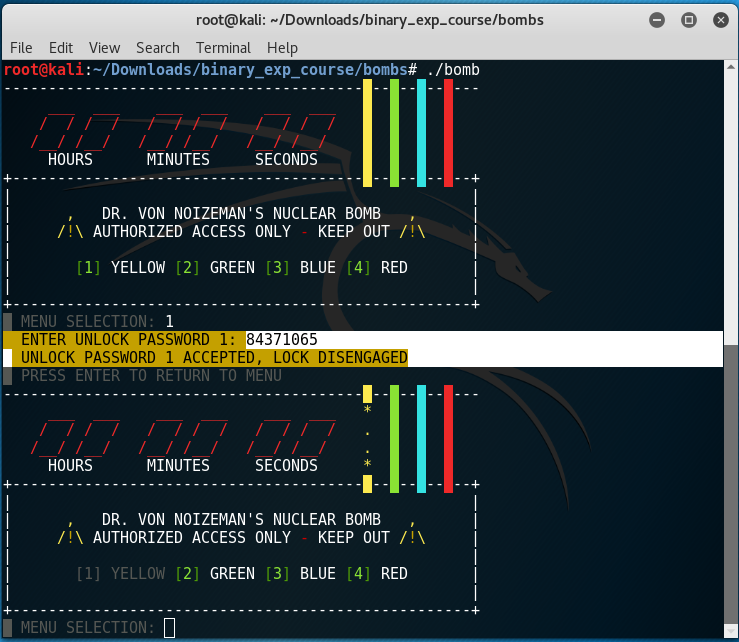
It worked! We cut the yellow wire.
Green
Disassembling green it’s easy to notice where our input is stored and that there is a string comparison with a string at address 0x804a2c0.
pwndbg> disass green
Dump of assembler code for function green:
0x08049904 <+0>: push ebp
0x08049905 <+1>: mov ebp,esp
0x08049907 <+3>: sub esp,0x38
0x0804990a <+6>: mov eax,gs:0x14
0x08049910 <+12>: mov DWORD PTR [ebp-0x4],eax
0x08049913 <+15>: xor eax,eax
0x08049915 <+17>: mov DWORD PTR [ebp-0x8],0x1
; [ebp-0x14] = user_input
0x0804991c <+24>: lea eax,[ebp-0x14]
0x0804991f <+27>: mov DWORD PTR [esp],eax
0x08049922 <+30>: call 0x80498d4 <green_preflight>
0x08049927 <+35>: mov DWORD PTR [esp+0x8],0x8
0x0804992f <+43>: lea eax,[ebp-0x14]
0x08049932 <+46>: mov DWORD PTR [esp+0x4],eax
0x08049936 <+50>: mov DWORD PTR [esp],0x804a2c0
; strncmp(0x804a2c0, user_input, 8)
0x0804993d <+57>: call 0x80487d4 <strncmp@plt>
0x08049942 <+62>: test eax,eax
; to go to 'UNLOCK PASSWORD ACCEPTED' strings should be equal
0x08049944 <+64>: jne 0x804998e <green+138>
0x08049946 <+66>: mov DWORD PTR [esp],0x804a2fc
; puts('UNLOCK PASSWORD ACCEPTED')
0x0804994d <+73>: call 0x80487b4 <puts@plt>
0x08049952 <+78>: mov eax,DWORD PTR [ebp-0x8]
0x08049955 <+81>: and eax,0x1
0x08049958 <+84>: test eax,eax
0x0804995a <+86>: sete al
0x0804995d <+89>: movzx eax,al
0x08049960 <+92>: mov DWORD PTR [ebp-0x8],eax
0x08049963 <+95>: mov DWORD PTR [esp],0x7a120
0x0804996a <+102>: call 0x8048724 <usleep@plt>
0x0804996f <+107>: mov DWORD PTR [esp],0x804a33c
; puts('ACTION OVERRIDEN....')
0x08049976 <+114>: call 0x80487b4 <puts@plt>
0x0804997b <+119>: mov eax,DWORD PTR [ebp-0x8]
0x0804997e <+122>: and eax,0x1
0x08049981 <+125>: test eax,eax
0x08049983 <+127>: sete al
0x08049986 <+130>: movzx eax,al
0x08049989 <+133>: mov DWORD PTR [ebp-0x8],eax
0x0804998c <+136>: jmp 0x804999a <green+150>
0x0804998e <+138>: mov eax,ds:0x804c12c
0x08049993 <+143>: add eax,eax
0x08049995 <+145>: mov ds:0x804c12c,eax
0x0804999a <+150>: mov eax,DWORD PTR [ebp-0x8]
0x0804999d <+153>: test eax,eax
0x0804999f <+155>: jne 0x80499ad <green+169>
0x080499a1 <+157>: mov eax,ds:0x804c12c
0x080499a6 <+162>: sar eax,1
0x080499a8 <+164>: mov ds:0x804c12c,eax
0x080499ad <+169>: mov eax,DWORD PTR [ebp-0x4]
0x080499b0 <+172>: xor eax,DWORD PTR gs:0x14
0x080499b7 <+179>: je 0x80499be <green+186>
0x080499b9 <+181>: call 0x8048784 <__stack_chk_fail@plt>
0x080499be <+186>: leave
0x080499bf <+187>: ret
And as you can see the address 0x804a2c0 points to the string "dcaotdae".
pwndbg> x/s 0x804a2c0
0x804a2c0 <password>: "dcaotdae"
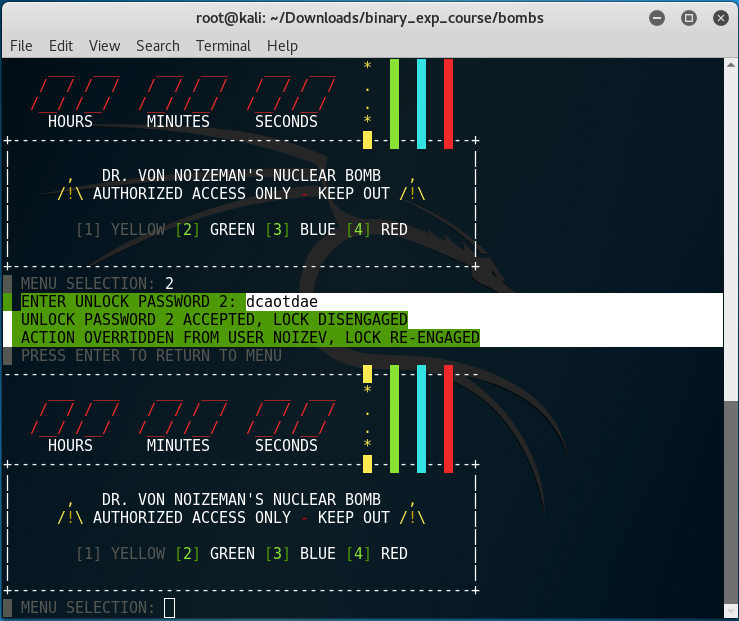
Blue
pwndbg> disass blue_preflight
Dump of assembler code for function blue_preflight:
0x080499c0 <+0>: push ebp
0x080499c1 <+1>: mov ebp,esp
0x080499c3 <+3>: sub esp,0x18
0x080499c6 <+6>: mov DWORD PTR [esp],0x804a388
0x080499cd <+13>: call 0x8048744 <printf@plt>
0x080499d2 <+18>: mov eax,ds:0x804c220
0x080499d7 <+23>: mov DWORD PTR [esp+0x8],eax
0x080499db <+27>: mov DWORD PTR [esp+0x4],0x10
; user_input is saved at 0x804c24c; max of 16 characters
0x080499e3 <+35>: mov DWORD PTR [esp],0x804c24c
0x080499ea <+42>: call 0x8048704 <fgets@plt>
0x080499ef <+47>: leave
0x080499f0 <+48>: ret
pwndbg> disass blue
Dump of assembler code for function blue:
0x080499f1 <+0>: push ebp
0x080499f2 <+1>: mov ebp,esp
0x080499f4 <+3>: sub esp,0x18
0x080499f7 <+6>: call 0x80499c0 <blue_preflight>
; [ebp-0x4] =: 0x804c160
0x080499fc <+11>: mov DWORD PTR [ebp-0x4],0x804c160
....
Hmm… Let’s see what’s at address 0x804c160
pwndbg> x/x 0x804c160
0x804c160 <graph>: 0x0804c19c
It’s a variable called graph and it appears to hold value that looks like an address. Let’s check if it poinsts to anywhere interesting.
pwndbg> x/x 0x0804c19c
0x804c19c <graph+60>: 0x0804c1cc
Points another address that belongs to the same variable and holds another address. I guess it’s going to be the same for this one.
pwndbg> x/x 0x0804c1cc
0x804c1cc <graph+108>: 0x0804c1f0
Yep… Ok, let’s continue analysing the disassembly.
pwndbg> disass blue
Dump of assembler code for function blue:
0x080499f1 <+0>: push ebp
0x080499f2 <+1>: mov ebp,esp
0x080499f4 <+3>: sub esp,0x18
0x080499f7 <+6>: call 0x80499c0 <blue_preflight>
; [ebp-0x4] =: 0x804c160
; 0x804c160 is address of the graph variable
0x080499fc <+11>: mov DWORD PTR [ebp-0x4],0x804c160
; eax := 0x804c160
0x08049a03 <+18>: mov eax,DWORD PTR [ebp-0x4]
; eax := the value at [0x804c160 + 0x4]
0x08049a06 <+21>: mov eax,DWORD PTR [eax+0x4]
; [ebp-0x8] is var1
; var1 := the value at [0x804c160 + 0x4]
0x08049a09 <+24>: mov DWORD PTR [ebp-0x8],eax
And now to see what’s at address 0x804c160 + 0x4 :
pwndbg> x/x 0x804c160 + 0x4
0x804c164 <graph+4>: 0x47bbfa96
We’re at the same variable, but at this address it doen’t hold a valid address as a value. I’m going to check several consecutive values.
0x804c160 <graph>: 0x0804c19c ;valid address
pwndbg> x/x 0x804c160 + 4
0x804c164 <graph+4>: 0x47bbfa96 ; some value
pwndbg> x/x 0x804c160 + 8
0x804c168 <graph+8>: 0x0804c178 ; valid address
pwndbg> x/x 0x804c160 + 12
0x804c16c <graph+12>: 0x0804c214 ; valid address
pwndbg> x/x 0x804c160 + 16
0x804c170 <graph+16>: 0x50171a6e ; some value
pwndbg> x/x 0x804c160 + 20
0x804c174 <graph+20>: 0x0804c1b4 ; valid address
pwndbg> x/x 0x804c160 + 24
0x804c178 <graph+24>: 0x0804c1d8 ; valid address
pwndbg> x/x 0x804c160 + 28
0x804c17c <graph+28>: 0x23daf3f1 ; some value
pwndbg> x/x 0x804c160 + 32
0x804c180 <graph+32>: 0x0804c1a8 ; valid address
pwndbg> x/x 0x804c160 + 36
0x804c184 <graph+36>: 0x0804c19c ; valid address
pwndbg> x/x 0x804c160 + 40
0x804c188 <graph+40>: 0x634284d3 ; some value
pwndbg> x/x 0x804c160 + 44
0x804c18c <graph+44>: 0x0804c1c0 ; valid address
And a pattern emerges. For now I’ll continue analysing the disassembly.
pwndbg> disass blue
Dump of assembler code for function blue:
0x080499f1 <+0>: push ebp
0x080499f2 <+1>: mov ebp,esp
0x080499f4 <+3>: sub esp,0x18
0x080499f7 <+6>: call 0x80499c0 <blue_preflight>
; [ebp-0x4] =: 0x804c160
; 0x804c160 is address of the graph variable
0x080499fc <+11>: mov DWORD PTR [ebp-0x4],0x804c160
; eax := 0x804c160
0x08049a03 <+18>: mov eax,DWORD PTR [ebp-0x4]
; eax := the value at [0x804c160 + 0x4]
0x08049a06 <+21>: mov eax,DWORD PTR [eax+0x4]
; [ebp-0x8] is var1
; var1 := some the value at [0x804c160 + 0x4] that is not a valid address
0x08049a09 <+24>: mov DWORD PTR [ebp-0x8],eax
; [ebp-0xc] is initialized to 0.
; Now look at address 0x08049a80 <+143>. 1 is added to it
; and if [ebp-0xc] is <= 14 execution returns to 0x8049a15
; I'm pretty sure [ebp-0xc] is an iterator for a loop
; [ebp-0xc] is i := 0
0x08049a0c <+27>: mov DWORD PTR [ebp-0xc],0x0
; jump to the check if i<= 14. If so return to the
; next instruction at 0x08049a15
0x08049a13 <+34>: jmp 0x8049a84 <blue+147>
; [ebp-0x10] is initialized to zero
; Later in the disassembly you can see that it only gets
; assigned 1 or 0. No other operations with it.
; I think it's some kind of flag that tells if something happpened or not.
; [ebp-0x10] is flag := 0
0x08049a15 <+36>: mov DWORD PTR [ebp-0x10],0x0
0x08049a1c <+43>: mov eax,DWORD PTR [ebp-0xc]
; if you remember 0x804c24c is where our input is stored.
; and eax holds the iterator
; eax := [i + &input] = user_input[i]
0x08049a1f <+46>: movzx eax,BYTE PTR [eax+0x804c24c]
0x08049a26 <+53>: movsx eax,al
; [ebp-0x14] := user_input[i]
0x08049a29 <+56>: mov DWORD PTR [ebp-0x14],eax
; 0x4c = ascii L
; Compare user_input[i] with 'L'
0x08049a2c <+59>: cmp DWORD PTR [ebp-0x14],0x4c
; jump to SECTION L if user_input[i] == 'L'
0x08049a30 <+63>: je 0x8049a40 <blue+79>
; 0x52 = ascii R (right)
; Compare user_input[i] with 'R'
0x08049a32 <+65>: cmp DWORD PTR [ebp-0x14],0x52
; jump to SECTION R if user_input[i] == 'R'
0x08049a36 <+69>: je 0x8049a4a <blue+89>
; 0xa = ascii newline
; Compare user_input[i] with '\n'
0x08049a38 <+71>: cmp DWORD PTR [ebp-0x14],0xa
; jump to SECTION \n if user_input[i] == '\n'
0x08049a3c <+75>: je 0x8049a55 <blue+100>
; if none matched jump to SECTION NONE
0x08049a3e <+77>: jmp 0x8049a5e <blue+109>
;SECTION L -> GO HERE IF user_input[i] == 'L'
;
; [ebp-0x4] was holding the graph variable address 0x804c160
; eax := 0x804c160
0x08049a40 <+79>: mov eax,DWORD PTR [ebp-0x4]
; eax := the value at [0x804c160] => 0x0804c19c
0x08049a43 <+82>: mov eax,DWORD PTR [eax]
; [ebp-0x4] now holds the NEW (next) address 0x0804c19c
0x08049a45 <+84>: mov DWORD PTR [ebp-0x4],eax
; jump to section CONT
0x08049a48 <+87>: jmp 0x8049a71 <blue+128>
;SECTION R -> GO HERE IF user_input[i] == 'R'
;
; [ebp-0x4] holds an address belonging to the graph variable
; eax := [ebp-0x4]
0x08049a4a <+89>: mov eax,DWORD PTR [ebp-0x4]
; eax := value at [eax+0x8]
; based on my findings of graph variable this should
; also be a valid address (because has an offset of 8)
0x08049a4d <+92>: mov eax,DWORD PTR [eax+0x8]
; [ebp-0x4] now holds NEW address but one found at an offset -0x8
0x08049a50 <+95>: mov DWORD PTR [ebp-0x4],eax
; jump to section CONT
0x08049a53 <+98>: jmp 0x8049a71 <blue+128>
;SECTION \n -> GO HERE IF user_input[i] == '\n'
; flag gets set to 1
; flag := 1
0x08049a55 <+100>: mov DWORD PTR [ebp-0x10],0x1
; jump to section CONT
0x08049a5c <+107>: jmp 0x8049a71 <blue+128>
;SECTION NONE
; flag is set to 1
; flag := 1
0x08049a5e <+109>: mov DWORD PTR [ebp-0x10],0x1
0x08049a65 <+116>: mov DWORD PTR [esp],0x804a3bb
; puts('boom')
0x08049a6c <+123>: call 0x80487b4 <puts@plt>
;SECTION CONT1 -> GO HERE AFTER 'L', 'R', '\n' SECTIONS
; Compare flag with 0
0x08049a71 <+128>: cmp DWORD PTR [ebp-0x10],0x0
; jump to section CONT2 if flag != 0
0x08049a75 <+132>: jne 0x8049a8a <blue+153>
; eax := [ebp-0x4] that holds the NEW address from the graph variable
0x08049a77 <+134>: mov eax,DWORD PTR [ebp-0x4]
; based on what I found on about the graph variable
; at offset 0x4 there is some value that is not a valid
; address
;eax := [eax+0x4] -> eax contains the value at an offset 0x4 from
; the SECOND address (i'll call it var2)
0x08049a7a <+137>: mov eax,DWORD PTR [eax+0x4]
; [ebp-0x8] was var1 which contained the value at offset of -0x4 to
; the FIRST address (the one we started with) of the graph variable
;
; eax now also contains some value (var2) with an offset of -0x4 but from the
; SECOND address
;
; var1 = var1 XOR var2
0x08049a7d <+140>: xor DWORD PTR [ebp-0x8],eax
; i++
0x08049a80 <+143>: add DWORD PTR [ebp-0xc],0x1
; Compare i with 14
0x08049a84 <+147>: cmp DWORD PTR [ebp-0xc],0xe
; jump if i <= 14
; our input should be no more than 14 characters
0x08049a88 <+151>: jle 0x8049a15 <blue+36>
;SECTION CONT2 -> GO HERE IF flag != 0
; this is the end of the function so I'm pretty sure the flag
; tells if we reached the end of our input (reached newline) or
; that we typed an invalid character
0x08049a8a <+153>: mov DWORD PTR [esp],0x804a3c0
0x08049a91 <+160>: call 0x8048744 <printf@plt>
0x08049a96 <+165>: mov eax,ds:0x804c240
0x08049a9b <+170>: mov DWORD PTR [esp],eax
0x08049a9e <+173>: call 0x8048734 <fflush@plt>
0x08049aa3 <+178>: mov DWORD PTR [esp],0x1
0x08049aaa <+185>: call 0x80487a4 <sleep@plt>
0x08049aaf <+190>: mov DWORD PTR [esp],0x804a3eb
0x08049ab6 <+197>: call 0x80487b4 <puts@plt>
0x08049abb <+202>: mov DWORD PTR [esp],0x7a120
0x08049ac2 <+209>: call 0x8048724 <usleep@plt>
0x08049ac7 <+214>: mov eax,ds:0x804a384
; Compare var1 with the value at address ds:0x804a384
0x08049acc <+219>: cmp DWORD PTR [ebp-0x8],eax
0x08049acf <+222>: jne 0x8049aec <blue+251>
0x08049ad1 <+224>: mov DWORD PTR [esp],0x804a3fc
0x08049ad8 <+231>: call 0x80487b4 <puts@plt>
0x08049add <+236>: mov eax,ds:0x804c140
0x08049ae2 <+241>: sub eax,0x1
0x08049ae5 <+244>: mov ds:0x804c140,eax
0x08049aea <+249>: jmp 0x8049af9 <blue+264>
0x08049aec <+251>: mov eax,ds:0x804c140
0x08049af1 <+256>: add eax,0x1
0x08049af4 <+259>: mov ds:0x804c140,eax
0x08049af9 <+264>: leave
0x08049afa <+265>: ret
Well, it’s a mess looking at this disassembly, and my comments are for sure confusing, so I’ll show some screenshots from the IDA graph view. But first, lets summarize:
- The only valid input characters are
'L','R'and'\n' - Input should be no more thatn 14 characters long
- Also now I’m sure that our graph variable is kind of a linked list with structures of the form:
struct graph{ // example address 0x804c160
int next_1; // 0x804c160 + 0x0 -> 0x0804c19c
int value; // 0x804c160 + 0x4 -> 0x47bbfa96
int next_2; // 0x804c160 + 0x8 -> 0x0804c178
}
And the connected elements are forming a…. graph. And at each node you could go ‘L’eft and ‘R’ight on the graph.
- At the end our
var1is compared to a value at address0x804a384which is equal to:
pwndbg> x/wx 0x804a384
0x804a384 <solution>: 0x40475194
That means after all iterations var1 should be equal to 0x40475194.
So we enter a path in the form 'LLRRLRLRLLR' and the values of each node with pass through and the expected result shuld be 0x40475194.
And below are screenshots from the IDA graph view (if it’s hard to see open them in a new tab):


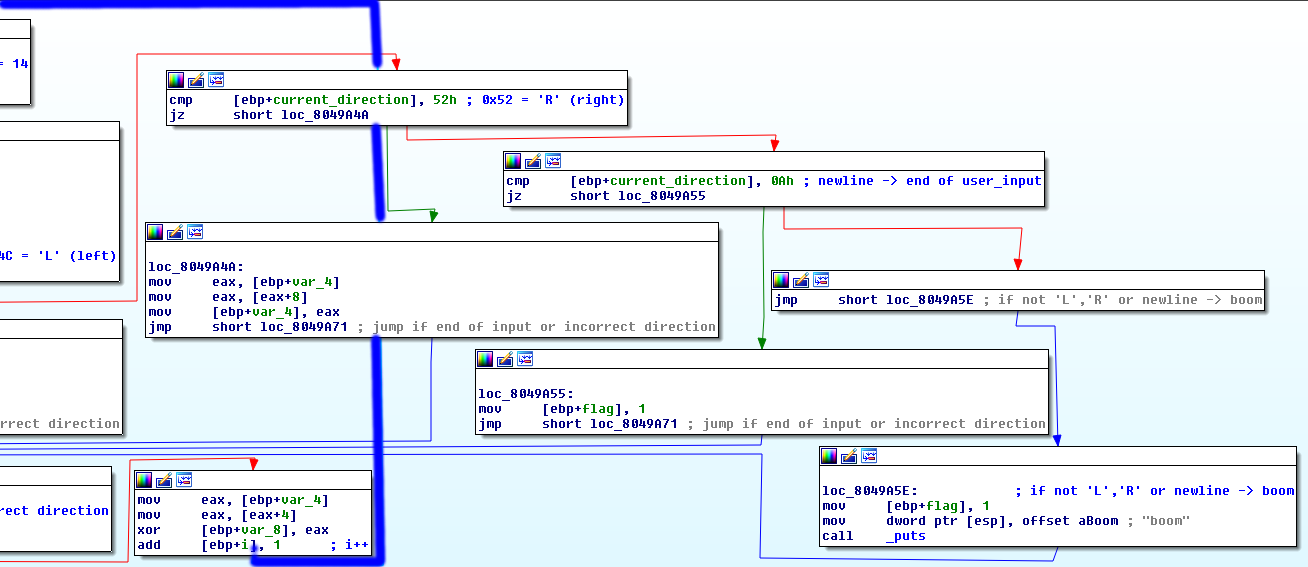
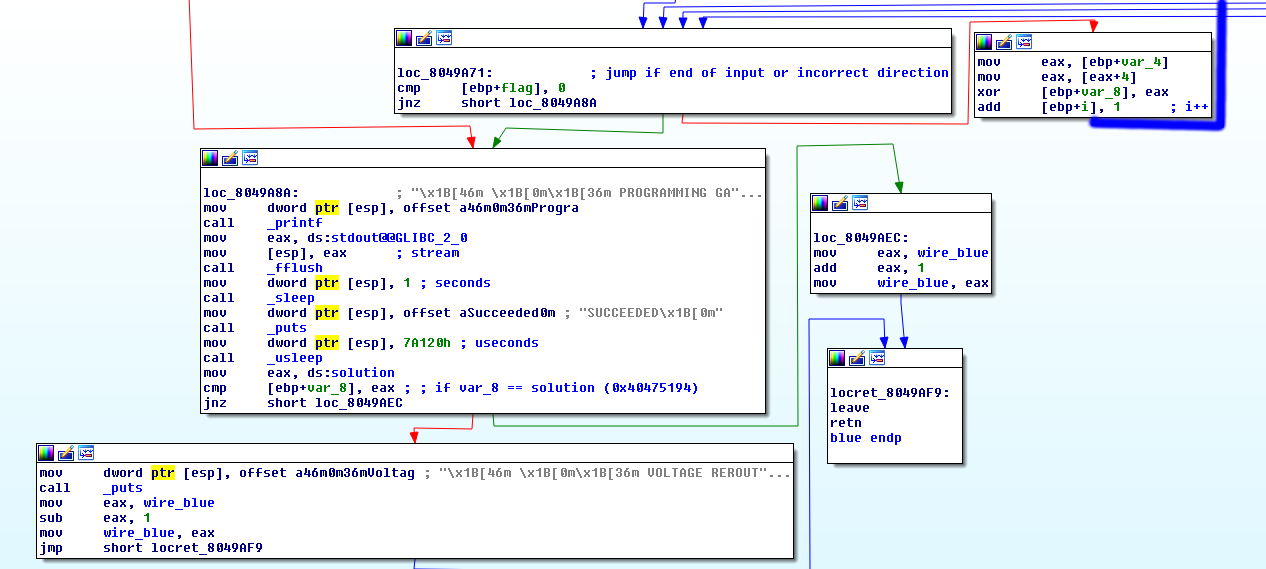
I found all nodes and their values manually, and wrote the following python script that bruteforces the solution by trying all possible paths.
#!/usr/bin/env python3
class graph:
def __init__(self, value):
self.value = value
self.left = None
self.right = None
c160 = graph(0x47bbfa96)
c19c = graph(0x0c4079ef)
c1cc = graph(0x4b846cb6)
c1f0 = graph(0x16848c16)
c184 = graph(0x634284d3)
c1c0 = graph(0x237a3a88)
c1e4 = graph(0x3a4ad3ff)
c1a8 = graph(0x425ebd95)
c178 = graph(0x23daf3f1)
c1d8 = graph(0x1fba9a98)
c214 = graph(0x770ea82a)
c1fc = graph(0x499ee4ce)
c190 = graph(0x344c4eb1)
c1b4 = graph(0x07ace749)
c160.right = c178
c19c.right = c214
c1cc.right = c184
c1f0.right = c178
c184.right = c1c0
c1c0.right = c184
c1e4.right = c1c0
c1a8.right = c184
c178.right = c1a8
c1d8.right = c1c0
c214.right = c1fc
c1fc.right = c1b4
c190.right = c1fc
c1b4.right = c1a8
c160.left = c19c
c19c.left = c1cc
c1cc.left = c1f0
c1f0.left = c184
c184.left = c19c
c1c0.left = c1e4
c1e4.left = c19c
c1a8.left = c178
c178.left = c1d8
c1d8.left = c214
c214.left = c1cc
c1fc.left = c190
c190.left = c1f0
c1b4.left = c1cc
solution = 0x40475194
def find_key(directions):
for i,d in enumerate(directions):
if i == 0:
k = c160
xored = k.value
if d == 'L':
k = k.left
v = k.value
xored = xored ^ v
if d == 'R':
k = k.right
v = k.value
xored = xored ^ v
if xored == solution:
print("Sucess! Found Key!")
print("Key: %s" % (directions))
input()
for pos in range(2,15):
print("Positions: %d" % (pos))
print("Combinations to try: %d" % (2**pos))
for i in range(2**pos):
# format binary with fixed length of 'pos' positions
format_string = '{0:0'+str(pos)+'b}'
binary = format_string.format(i)
combination = binary.replace('0','L').replace('1','R')
find_key(combination)
print("==========================")
$ ./blue.py
Positions: 2
Combinations to try: 4
==========================
Positions: 3
Combinations to try: 8
==========================
Positions: 4
Combinations to try: 16
Sucess! Found Key!
Key: LLRR
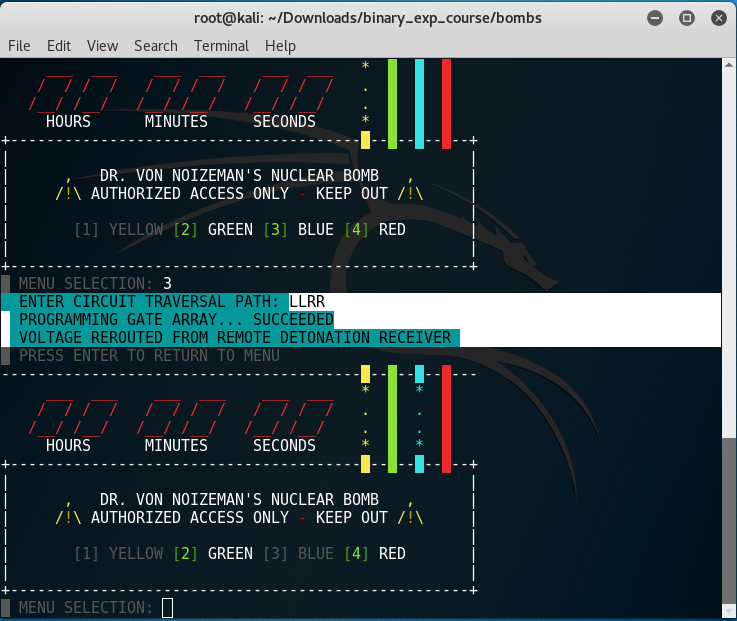
Red
When you run the RED option three hexadecimal numbers are generated:
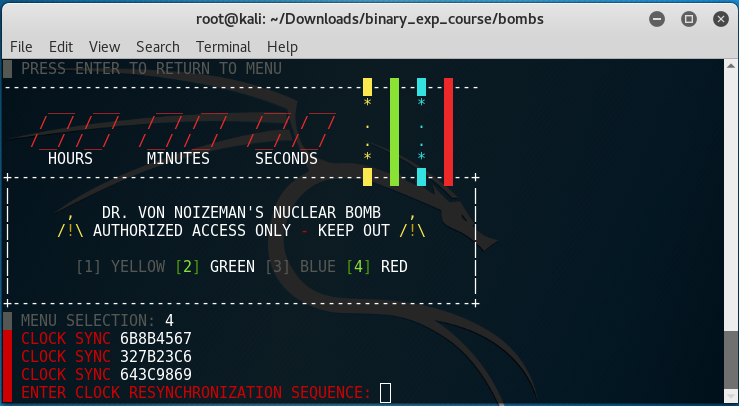
This time the preflight function is important.
pwndbg> disass red_preflight
Dump of assembler code for function red_preflight:
0x080497a4 <+0>: push ebp
0x080497a5 <+1>: mov ebp,esp
0x080497a7 <+3>: sub esp,0x28
0x080497aa <+6>: call 0x80487c4 <rand@plt>
0x080497af <+11>: and eax,0x7fffffff
; 0x804c264 points to variable I'll call rnd1
; rnd1 := random && 0x7fffffff
0x080497b4 <+16>: mov ds:0x804c264,eax
0x080497b9 <+21>: call 0x80487c4 <rand@plt>
; 0x804c268 is rnd2 := random
0x080497be <+26>: mov ds:0x804c268,eax
0x080497c3 <+31>: call 0x80487c4 <rand@plt>
; 0x804c26c is rnd3 := random
; Thes three random numbers are consecutive and
; can be referenced as an array rnd[i] with first element rnd1
0x080497c8 <+36>: mov ds:0x804c26c,eax
; [ebp-0x4] is an interatior
; At address 0x080497fc it is incremented and
; after that a compare and a jump
; i := 0
0x080497cd <+41>: mov DWORD PTR [ebp-0x4],0x0
0x080497d4 <+48>: jmp 0x8049800 <red_preflight+92>
0x080497d6 <+50>: mov eax,DWORD PTR [ebp-0x4]
; iterate through rnd[i]
; eax := i*4 + &rnd1 equivalent to rnd[i]
0x080497d9 <+53>: mov eax,DWORD PTR [eax*4+0x804c264]
0x080497e0 <+60>: mov DWORD PTR [esp+0x4],eax
; printf('CLOCK SYNC: rnd[i]')
0x080497e4 <+64>: mov DWORD PTR [esp],0x804a234
0x080497eb <+71>: call 0x8048744 <printf@plt>
0x080497f0 <+76>: mov DWORD PTR [esp],0x7a120
0x080497f7 <+83>: call 0x8048724 <usleep@plt>
; i++
0x080497fc <+88>: add DWORD PTR [ebp-0x4],0x1
; compare i with 0x2
0x08049800 <+92>: cmp DWORD PTR [ebp-0x4],0x2
; loop if i <= 0x2 (loop through the random numbers)
0x08049804 <+96>: jle 0x80497d6 <red_preflight+50>
0x08049806 <+98>: mov DWORD PTR [esp],0x804a25c
0x0804980d <+105>: call 0x8048744 <printf@plt>
0x08049812 <+110>: mov eax,ds:0x804c220
0x08049817 <+115>: mov DWORD PTR [esp+0x8],eax
0x0804981b <+119>: mov DWORD PTR [esp+0x4],0x15
; 0x804c24c = user_input
0x08049823 <+127>: mov DWORD PTR [esp],0x804c24c
0x0804982a <+134>: call 0x8048704 <fgets@plt>
0x0804982f <+139>: leave
0x08049830 <+140>: ret
End of assembler dump.
pwndbg> disass red
Dump of assembler code for function red:
0x08049831 <+0>: push ebp
0x08049832 <+1>: mov ebp,esp
0x08049834 <+3>: sub esp,0x18
0x08049837 <+6>: call 0x80497a4 <red_preflight>
; [ebp-0x4] := 0x804a29c
; where 0x804a29c points to an array with alphanumeric characters
; [ebp-0x4] is characters := "ABCDEFGHJKLMNPQRSTUVWXYZ23456789"
0x0804983c <+11>: mov DWORD PTR [ebp-0x4],0x804a29c
; [ebp-0x8] is an iterator i := 0 to 18
0x08049843 <+18>: mov DWORD PTR [ebp-0x8],0x0
0x0804984a <+25>: jmp 0x80498ba <red+137>
0x0804984c <+27>: mov eax,DWORD PTR [ebp-0x8]
; 0x804c24c points to the user_input
; edx := user_input[i]
0x0804984f <+30>: movzx edx,BYTE PTR [eax+0x804c24c]
0x08049856 <+37>: mov eax,ds:0x804c26c
; eax = rnd3 && 0x1f
0x0804985b <+42>: and eax,0x1f
; eax := &characters[eax]
0x0804985e <+45>: add eax,DWORD PTR [ebp-0x4]
; eax := characters[eax]
0x08049861 <+48>: movzx eax,BYTE PTR [eax]
0x08049864 <+51>: cmp dl,al
; jump if user_input[i] == characters[rnd3 && 0x1f]
0x08049866 <+53>: je 0x8049877 <red+70>
0x08049868 <+55>: mov eax,ds:0x804c128
0x0804986d <+60>: add eax,0x1
0x08049870 <+63>: mov ds:0x804c128,eax
; if user_input[i] != characters -> exit
0x08049875 <+68>: jmp 0x80498ca <red+153>
0x08049877 <+70>: mov eax,ds:0x804c26c
0x0804987c <+75>: mov edx,eax
; edx := rnd3 >> 0x5
0x0804987e <+77>: shr edx,0x5
0x08049881 <+80>: mov eax,ds:0x804c268
; eax := rnd2 << 0x1b
0x08049886 <+85>: shl eax,0x1b
; eax := (rnd2 << 0x1b) || (rnd3 >> 0x5)
0x08049889 <+88>: or eax,edx
; rnd3 := (rnd2 << 0x1b) || (rnd3 >> 0x5)
0x0804988b <+90>: mov ds:0x804c26c,eax
0x08049890 <+95>: mov eax,ds:0x804c268
0x08049895 <+100>: mov edx,eax
; edx := rnd2 >> 0x5
0x08049897 <+102>: shr edx,0x5
0x0804989a <+105>: mov eax,ds:0x804c264
; eax := rnd1 << 0x1b
0x0804989f <+110>: shl eax,0x1b
0x080498a2 <+113>: or eax,edx
; rdn2 = (rnd1 << 0x1b) || (rnd2 >> 0x5)
0x080498a4 <+115>: mov ds:0x804c268,eax
0x080498a9 <+120>: mov eax,ds:0x804c264
0x080498ae <+125>: shr eax,0x5
; rnd1 := rnd1 >> 0x5
0x080498b1 <+128>: mov ds:0x804c264,eax
; i++
0x080498b6 <+133>: add DWORD PTR [ebp-0x8],0x1
0x080498ba <+137>: cmp DWORD PTR [ebp-0x8],0x12
; jump if i<= 18
0x080498be <+141>: jle 0x804984c <red+27>
0x080498c0 <+143>: mov DWORD PTR ds:0x804c128,0x0
0x080498ca <+153>: leave
0x080498cb <+154>: ret
End of assembler dump.
And the IDA graph view:
preflight:
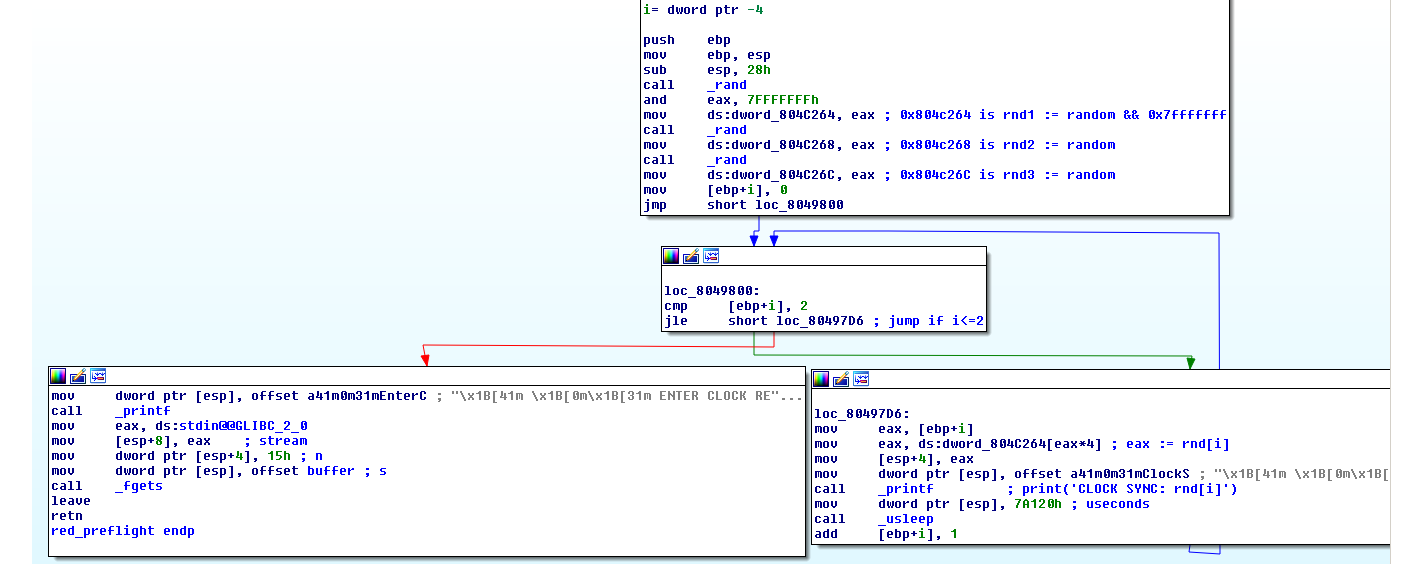
red:
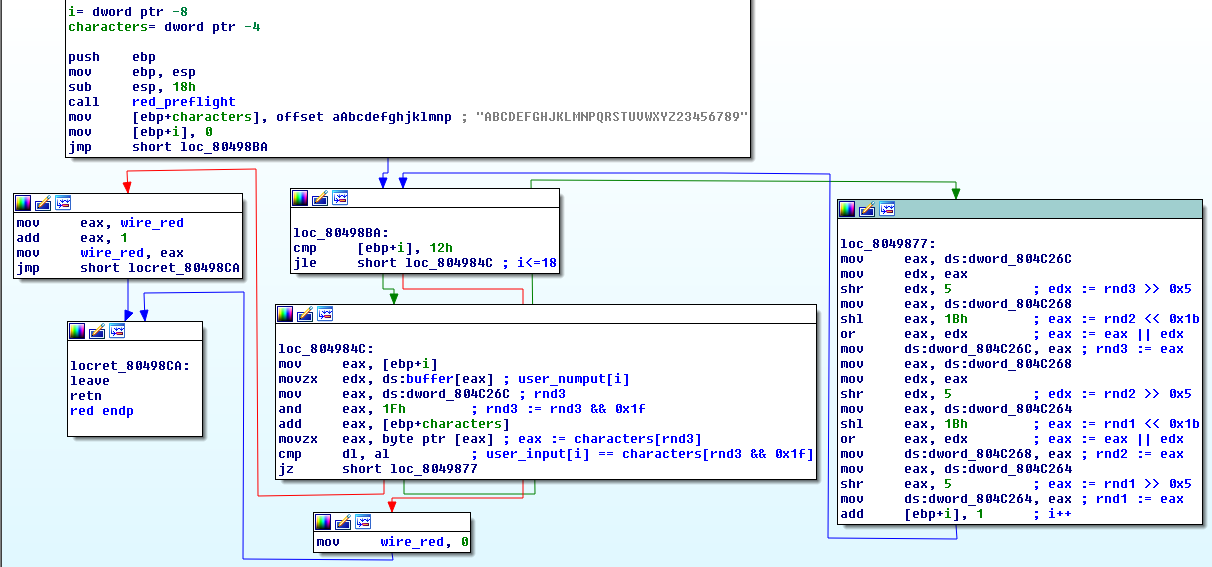
It’s obvious what it does.
- It generates 3 random numbers
- Based on those random numbers it calculates what input characters to expect
It’s trivial to do it in a python script:
#!/usr/bin/env python3
characters = 'ABCDEFGHJKLMNPQRSTUVWXYZ23456789'
length = 18
rnd1 = int(input("RND1: "), 16)
rnd2 = int(input("RND2: "), 16)
rnd3 = int(input("RND3: "), 16)
key = []
for i in range(length + 1):
key.append( characters[rnd3 & 0x1f] )
rnd3 = (rnd2 << 0x1b) | (rnd3 >> 0x5)
rnd2 = (rnd1 << 0x1b) | (rnd2 >> 0x5)
rnd1 = rnd1 >> 0x5
print('Key: %s' % (''.join(key)))
Run the script and copy the random numbers that the executable generated.
$ ./red.py
RND1: 6B8B4567
RND2: 327B23C6
RND3: 643C9869
Key: KDG3DU32D38EVVXJM64
Test the key:
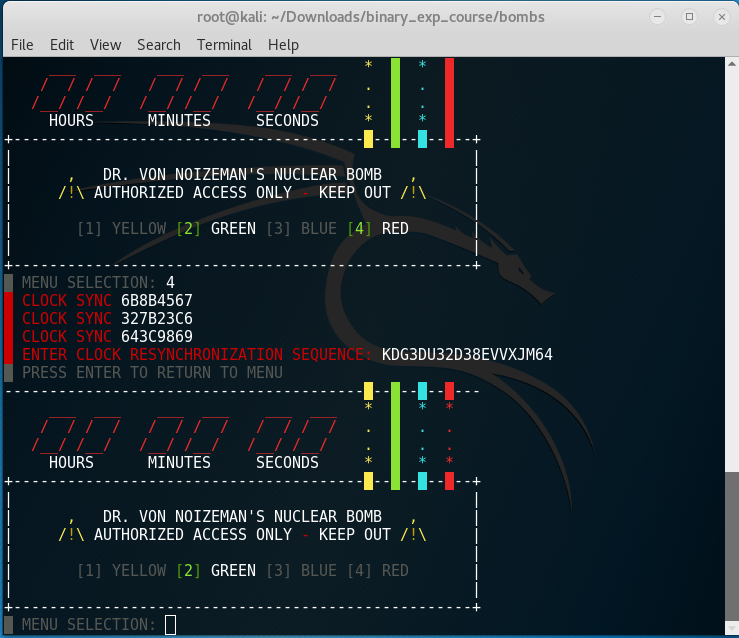
That’s it for now. Part 0x02 will be a write up for the cmubomb executable.
